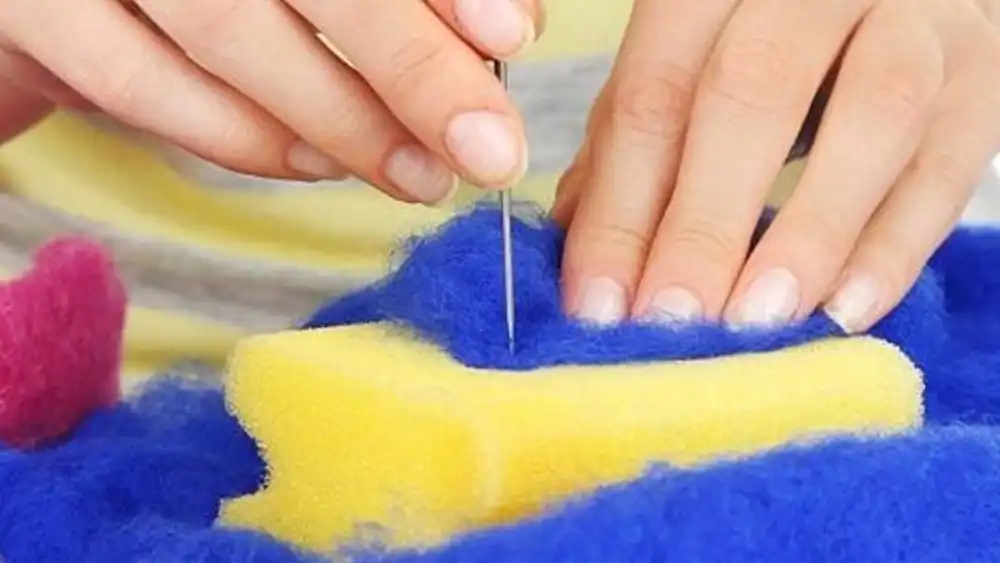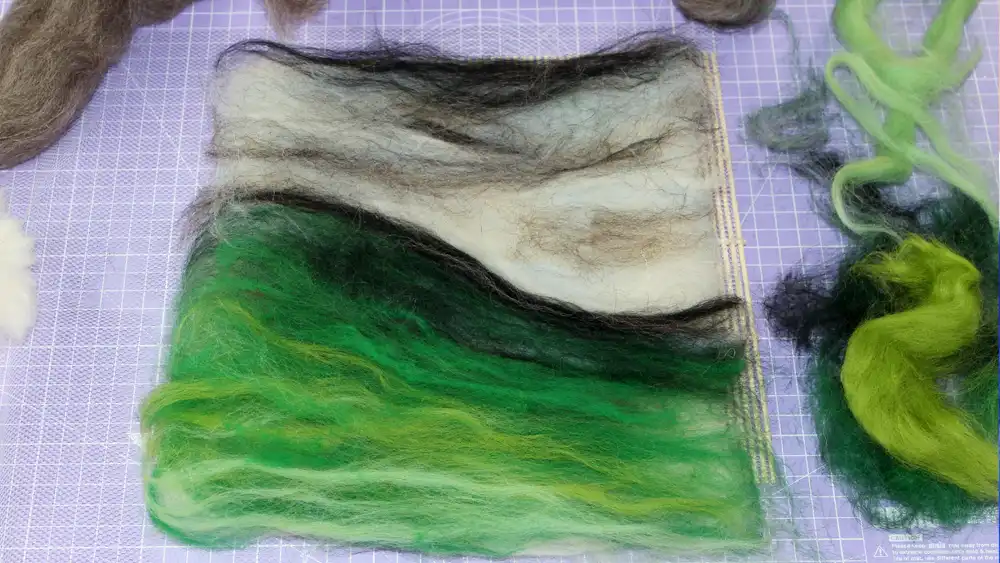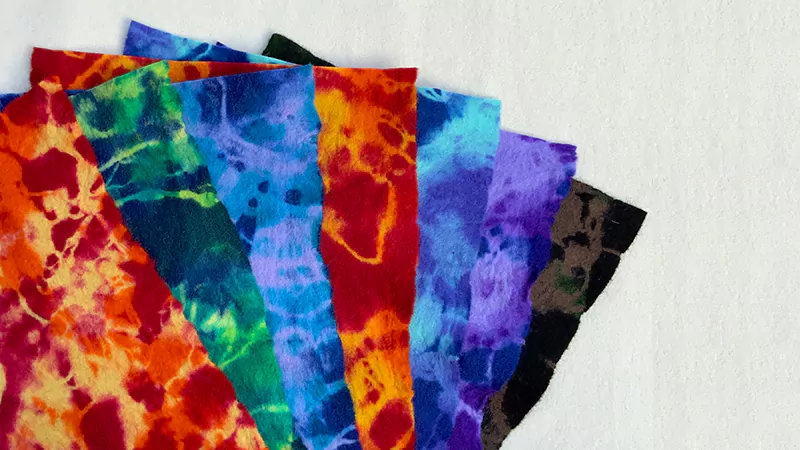Felting wool fabric is a timeless craft that transforms raw wool into a sturdy, versatile material suitable for various projects. Whether you’re a seasoned crafter or a curious beginner, learning how to felt wool opens up a world of creative possibilities.
In this guide, we’ll delve into the intricacies of felting wool fabric, exploring techniques, tools, and tips to help you master this art form.
What is Felt?
Felt is a versatile textile material crafted from 100% natural sheep wool. It is formed through a process of matting, condensing, and pressing the wool fibers together, resulting in a dense, durable fabric. Felt has been used for centuries in various cultures for making clothing, accessories, and decorative items, due to its unique properties and ability to retain warmth.
The transformation of individual strands of wool into a cohesive and beautiful material is truly remarkable. Essentially, wool felting is the artistic process of shaping and molding wool into various forms, allowing for endless creative possibilities.
Different Types of Felting

Felting encompasses various techniques and methods, each yielding distinct results. Here are some common types of felting:
Wet Felting: This is the traditional method of felting wool by combining hot water, soap, and agitation to bond the fibers together. Wet felting is ideal for creating flat sheets of felt or shaping three-dimensional objects like hats and bowls.
Needle Felting: Needle felting involves using special barbed needles to sculpt and compact wool fibers into desired shapes. Unlike wet felting, needle felting does not require water or soap, making it a convenient option for detailed designs and small-scale projects.
Nuno Felting: Nuno felting combines wool fibers with a base fabric, such as silk or cotton, to create lightweight and textured garments or accessories. This technique allows for intricate designs and beautiful layering effects, resulting in unique and versatile textiles.
Dry Felting: Dry felting, also known as needle felting, involves using a felting needle to interlock wool fibers and create felted sculptures or embellishments. This technique is popular for its precision and versatility, allowing artists to create intricate details and textures in their work.
Fulling: Fulling is a process that involves subjecting woven or knitted wool fabric to heat, moisture, and agitation to shrink and strengthen the fibers. While not technically felting in the traditional sense, fulling produces a dense, felt-like fabric that is durable and water-resistant.
Combination Felting: Some felting projects may incorporate a combination of wet felting, needle felting, and other techniques to achieve specific effects or textures. Experimenting with different felting methods allows artists to push the boundaries of their creativity and explore new possibilities in fiber art.
How to Felt Wool Fabric Step by Step

Felted wool fabric can be created through the process of wet felting, which involves combining hot water, soap, and agitation to bond wool fibers together. Here’s a step-by-step guide on how to felt wool fabric:
Step 1: Gather Your Materials:
- Raw wool roving or yarn (preferably non-superwash wool)
- Hot water
- Mild soap or wool wash
- A large basin or sink
- Towels
- Optional: Bubble wrap or bamboo sushi mat for rolling
Step 2: Prepare Your Wool:
- Pull apart the wool roving into thin, uniform strands or use pre-spun wool yarn.
- Arrange the wool fibers in overlapping layers to create a flat or three-dimensional shape, depending on your desired outcome.
Step 3: Create a Soap Solution:
- Fill a basin or sink with hot water, ensuring it’s hot enough to open up the wool fibers but not scalding.
- Add a small amount of mild soap or wool wash to the water and mix until it’s evenly distributed.
Step 4: Soak the Wool:
- Submerge the arranged wool fibers in the soapy water, ensuring they are fully saturated.
- Gently press down on the wool to help it absorb the water and soap.
Step 5: Agitate the Wool:
- Using your hands or a gentle rubbing motion, agitate the wool fibers to encourage them to bond together.
- Continue agitating for several minutes, periodically checking the progress of the felting process.
Step 6: Roll the Wool:
- If creating a flat piece of felt, carefully roll the wool in a bamboo sushi mat or between layers of bubble wrap.
- Roll the wool back and forth, applying pressure to help compress the fibers and facilitate bonding.
- For three-dimensional shapes, shape the wool by hand or with the aid of a template, continuing to agitate and shape as needed.
Step 7: Check for Consistency:
- Periodically unroll the wool to check its progress. The fibers should start to mat together, forming a cohesive fabric.
- If any areas seem loose or fuzzy, gently rub or agitate them further to encourage felting.
Step 8: Rinse and Dry:
- Once the wool has felted to your satisfaction, rinse it thoroughly with clean water to remove any soap residue.
- Squeeze out excess water gently, taking care not to distort the shape of the felted fabric.
- Lay the felted wool flat on a towel and roll it up to absorb excess moisture.
- Allow the felted wool to air dry completely before using it for your desired project.
By following these steps, you can create beautiful and durable felted wool fabric suitable for a wide range of crafting projects. Experiment with different techniques and variations to discover your unique felting style.
Symptoms and Signs of Successful Felting
Determining when wool fibers have felted together properly requires keen observation and attention to detail. Here are some signs that indicate successful felting:
Fabric Density
Felted wool fabric should have a dense, uniform texture with minimal visible fibers. Gently squeeze the fabric to assess its firmness and resilience.
Shrinkage
During the felting process, wool fibers naturally shrink and mat together, resulting in a reduction in size. Measure your wool before and after felting to gauge the extent of shrinkage.
Cohesion
A well-felted fabric will exhibit strong cohesion, with fibers firmly interlocked to form a cohesive surface. Run your fingers across the fabric to test for any loose or fuzzy areas.
How to Felt Wool Fabric in Washing Machine
Felting wool fabric in a washing machine is a convenient and efficient method that produces consistent results. Here’s a step-by-step guide on how to felt wool fabric using a washing machine:
Select Suitable Wool:
- Choose wool roving or yarn labeled as “non-superwash” or “feltable.” Superwash wool has been treated to resist felting and may not yield satisfactory results.
Prepare Your Wool:
- Arrange the wool fibers in layers to create the desired shape or design. You can create a flat piece of felt or shape the wool into three-dimensional forms.
Load the Washing Machine:
- Place your prepared wool fabric in a mesh laundry bag or pillowcase to prevent loose fibers from clogging the washing machine.
Set the Washing Machine:
- Select a hot water cycle with a high agitation setting. The agitation is essential for matting the wool fibers together.
Add Soap:
- Add a small amount of mild soap or wool wash to the washing machine. Avoid using regular laundry detergent, as it may contain additives that interfere with the felting process.
Start the Cycle:
- Start the washing machine cycle and allow it to run through the wash and rinse cycles. The combination of hot water, soap, and agitation will encourage the wool fibers to bond together and felt.
Check Progress:
- Periodically pause the washing machine cycle to check the progress of the felting process. Carefully remove the wool fabric from the mesh bag or pillowcase and inspect it for signs of felting.
Repeat if Necessary:
- If the wool fabric has not felted to your satisfaction after the first cycle, you can run it through additional wash cycles until the desired level of felting is achieved.
Rinse and Dry:
- Once the wool fabric has felted to your liking, rinse it thoroughly with clean water to remove any soap residue.
- Gently squeeze out excess water and reshape the felted fabric as needed.
- Lay the felted wool flat on a towel and roll it up to absorb excess moisture.
- Allow the felted wool to air dry completely before using it for your desired project.
By following these steps, you can successfully felt wool fabric using a washing machine. Experiment with different wool types, agitation settings, and cycle durations to achieve the desired felting results for your projects.
Causes and Risk Factors of Felting Failure

While felting wool is a straightforward process, several factors can affect the outcome. Understanding these causes and risk factors can help troubleshoot common felting problems:
Inadequate Agitation
Insufficient agitation during the felting process can prevent wool fibers from properly matting together. Be sure to agitate your wool thoroughly, whether by hand or using a washing machine.
Incorrect Water Temperature
Water temperature plays a crucial role in felting, with hot water helping to open up wool fibers and facilitate bonding. Using water that is too cold may impede the felting process and result in incomplete or uneven felt.
Improper Wool Selection
Not all wool is created equal when it comes to felting. Choose wool roving or yarn labeled as “feltable” or “non-superwash,” as these varieties have been processed to retain their natural felting properties.
In the event of a felting mishap, don’t despair—there are several options for salvaging or repurposing your wool. Consider the following treatment options for failed felting attempts:
Re-Felting
If your wool fabric has not felted to your desired level of density or cohesion, you can attempt to re-felt it by subjecting it to additional agitation and hot water.
Embellishment
Transform partially felted wool into embellishments for future projects, such as appliqués, patches, or textured accents. Needle felting or embroidery can help enhance the visual appeal of your fabric.
Recycling
Repurpose failed felting projects by cutting them into smaller pieces for use in patchwork, quilting, or mixed-media art. Experiment with different techniques to incorporate felted wool into new and creative endeavors.
Essential Tips for Successful Felting

To enhance your felting experience and achieve great results, consider these essential tips and best practices:
Prepare Your Materials
Start with clean wool that is free of dirt and debris. Before you begin, pre-soak your wool in hot water mixed with a small amount of detergent. This step helps eliminate any residual oils or impurities, ensuring a smooth felting process.
Ensure Proper Agitation
Agitation is key to successful felting, as it promotes fiber entanglement and bonding. You can use your hands, a felting tool, or even a washing machine for thorough agitation. The more you agitate, the more the fibers will tangle together, leading to a solid felted piece.
Monitor Shrinkage Carefully
Monitor the shrinkage of your wool fabric closely during felting, adjusting water temperature and agitation as needed to achieve the desired size and density. Avoid excessive shrinkage by felting in small increments.
Embrace Patience and Persistence
Felting is an art that requires time, patience, and a willingness to experiment. Don’t be discouraged by challenges or less-than-perfect outcomes; each attempt is a valuable opportunity to improve your skills and refine your technique. Enjoy the journey of learning and creating with wool!
Conclusion
In conclusion, felting wool fabric is a rewarding and versatile craft that offers endless opportunities for creativity and self-expression. By mastering the techniques and principles outlined in this guide, you can embark on your felting journey with confidence and enthusiasm. Whether you’re creating functional textiles, intricate sculptures, or personal keepsakes, felting allows you to unleash your creativity and connect with a rich tradition of artisanal craftsmanship.
Remember to be patient, persistent, and open to experimentation as you explore the world of felting. With practice and dedication, you’ll develop your own unique style and create beautiful felted pieces that delight and inspire others.
